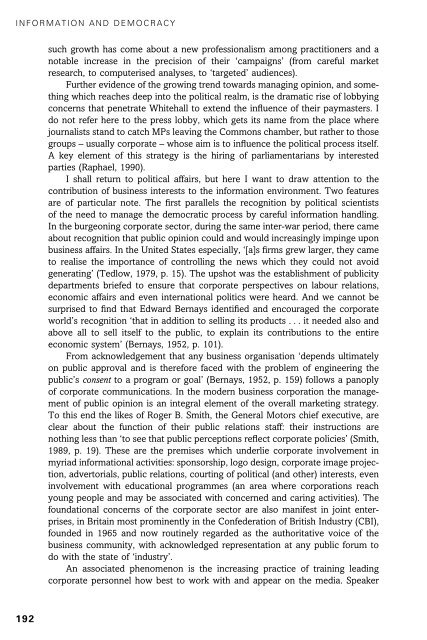Theories of the Information Society, Third Edition - Cryptome
Theories of the Information Society, Third Edition - Cryptome
Theories of the Information Society, Third Edition - Cryptome
You also want an ePaper? Increase the reach of your titles
YUMPU automatically turns print PDFs into web optimized ePapers that Google loves.
INFORMATION AND DEMOCRACY<br />
such growth has come about a new pr<strong>of</strong>essionalism among practitioners and a<br />
notable increase in <strong>the</strong> precision <strong>of</strong> <strong>the</strong>ir ‘campaigns’ (from careful market<br />
research, to computerised analyses, to ‘targeted’ audiences).<br />
Fur<strong>the</strong>r evidence <strong>of</strong> <strong>the</strong> growing trend towards managing opinion, and something<br />
which reaches deep into <strong>the</strong> political realm, is <strong>the</strong> dramatic rise <strong>of</strong> lobbying<br />
concerns that penetrate Whitehall to extend <strong>the</strong> influence <strong>of</strong> <strong>the</strong>ir paymasters. I<br />
do not refer here to <strong>the</strong> press lobby, which gets its name from <strong>the</strong> place where<br />
journalists stand to catch MPs leaving <strong>the</strong> Commons chamber, but ra<strong>the</strong>r to those<br />
groups – usually corporate – whose aim is to influence <strong>the</strong> political process itself.<br />
A key element <strong>of</strong> this strategy is <strong>the</strong> hiring <strong>of</strong> parliamentarians by interested<br />
parties (Raphael, 1990).<br />
I shall return to political affairs, but here I want to draw attention to <strong>the</strong><br />
contribution <strong>of</strong> business interests to <strong>the</strong> information environment. Two features<br />
are <strong>of</strong> particular note. The first parallels <strong>the</strong> recognition by political scientists<br />
<strong>of</strong> <strong>the</strong> need to manage <strong>the</strong> democratic process by careful information handling.<br />
In <strong>the</strong> burgeoning corporate sector, during <strong>the</strong> same inter-war period, <strong>the</strong>re came<br />
about recognition that public opinion could and would increasingly impinge upon<br />
business affairs. In <strong>the</strong> United States especially, ‘[a]s firms grew larger, <strong>the</strong>y came<br />
to realise <strong>the</strong> importance <strong>of</strong> controlling <strong>the</strong> news which <strong>the</strong>y could not avoid<br />
generating’ (Tedlow, 1979, p. 15). The upshot was <strong>the</strong> establishment <strong>of</strong> publicity<br />
departments briefed to ensure that corporate perspectives on labour relations,<br />
economic affairs and even international politics were heard. And we cannot be<br />
surprised to find that Edward Bernays identified and encouraged <strong>the</strong> corporate<br />
world’s recognition ‘that in addition to selling its products . . . it needed also and<br />
above all to sell itself to <strong>the</strong> public, to explain its contributions to <strong>the</strong> entire<br />
economic system’ (Bernays, 1952, p. 101).<br />
From acknowledgement that any business organisation ‘depends ultimately<br />
on public approval and is <strong>the</strong>refore faced with <strong>the</strong> problem <strong>of</strong> engineering <strong>the</strong><br />
public’s consent to a program or goal’ (Bernays, 1952, p. 159) follows a panoply<br />
<strong>of</strong> corporate communications. In <strong>the</strong> modern business corporation <strong>the</strong> management<br />
<strong>of</strong> public opinion is an integral element <strong>of</strong> <strong>the</strong> overall marketing strategy.<br />
To this end <strong>the</strong> likes <strong>of</strong> Roger B. Smith, <strong>the</strong> General Motors chief executive, are<br />
clear about <strong>the</strong> function <strong>of</strong> <strong>the</strong>ir public relations staff: <strong>the</strong>ir instructions are<br />
nothing less than ‘to see that public perceptions reflect corporate policies’ (Smith,<br />
1989, p. 19). These are <strong>the</strong> premises which underlie corporate involvement in<br />
myriad informational activities: sponsorship, logo design, corporate image projection,<br />
advertorials, public relations, courting <strong>of</strong> political (and o<strong>the</strong>r) interests, even<br />
involvement with educational programmes (an area where corporations reach<br />
young people and may be associated with concerned and caring activities). The<br />
foundational concerns <strong>of</strong> <strong>the</strong> corporate sector are also manifest in joint enterprises,<br />
in Britain most prominently in <strong>the</strong> Confederation <strong>of</strong> British Industry (CBI),<br />
founded in 1965 and now routinely regarded as <strong>the</strong> authoritative voice <strong>of</strong> <strong>the</strong><br />
business community, with acknowledged representation at any public forum to<br />
do with <strong>the</strong> state <strong>of</strong> ‘industry’.<br />
An associated phenomenon is <strong>the</strong> increasing practice <strong>of</strong> training leading<br />
corporate personnel how best to work with and appear on <strong>the</strong> media. Speaker<br />
192
















